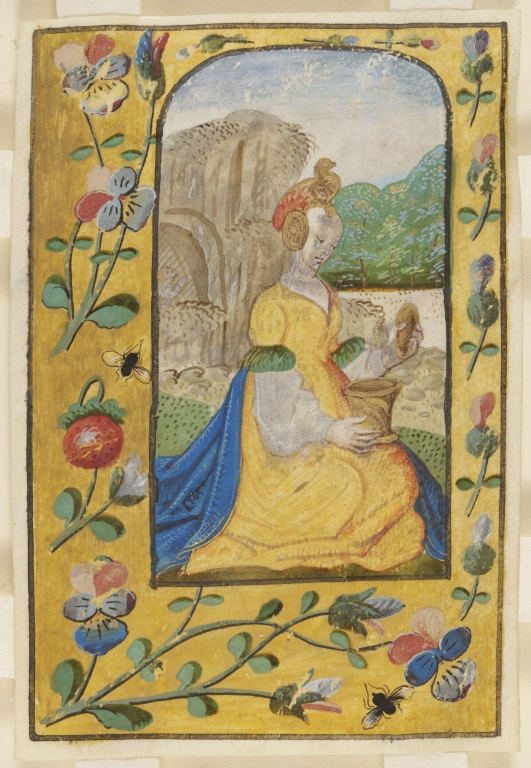Manuscript Cutting: Leaf with a Miniature of Mary Magdalene with Flowers

Unknown Artist
Leaf with a Miniature of Mary Magdalene with Flowers
South Netherlands, about 1500
Ink and pigment on parchment, 85 x 60 mm
Victoria and Albert Museum (No. 9021B)
Leaf, with a full-page miniature of Saint Mary Magdalene in a long yellow dress and wearing an extravagant hat, seated in a landscape. Her image is set within a border of realistic flower sprays and insects on a brushed gold ground, in the ‘Ghent-Bruges’ style of the period.
This cutting (like the Miniature of Saint Luke) was acquired in 1883 by William Henry James Weale (1832-1917), a British art historian and enthusiast of the gothic revival as well as a pioneer of early book binding. Weale went on to found the Guild of Saint Thomas and Saint Luke, a group of medievalist scholars focused on Christian perspective of arts and culture. Weale was buried at the church of Saint Mary Magdalene, Mortlake, Surrey, which suggests this cutting represented his interest in the specific saint and its Flemish style as he lived much of his life in Bruges.
In 1849, Weale published Flores Ecclesiae: the Saints of the Catholic Church arranged according to the Calendar, which explored visual attributes of saints such as specific associated flowers. Weale’s book states that the flower associated with Mary Magdalen’s feast day (22 July) is the African Lily, therefore linking the visual image of the flower with the celebration of her feast day. The connection Weale draws between Mary, the flower and femininity provides a strong link between visual devotion and the physical experience of faith.
Mary wears an escoffion, a horned head dress detailed with a bird that Weale described as ‘extravagant’. Mary Magdalene would have symbolised redemption and devotion to a medieval audience, as to a Victorian one. As a follower of Jesus, witness to his execution and in some accounts first to witness his resurrection, she symbolised a loyal, educated and devoted student of his teachings. This image enabled both the Victorian and medieval devotee to connect with her values of loyalty and studiousness.